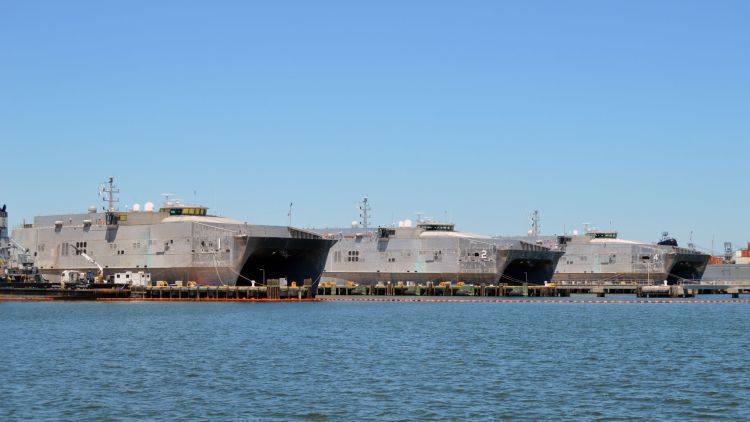In a bid to address a critical shortage of civilian mariners, Military Sealift Command (MSC) recently announced its plans to sideline 17 of its support ships to ease operational strain and improve workforce conditions.
MSC Chief Rear Admiral Philip Sobeck confirmed the decision during a press call on Thursday, November 21, describing it as essential to realigning the force and meeting fleet requirements.
MSC, responsible for manning the US Navy’s logistics and support vessels, currently operates with a mariner-to-billet ratio of 1.27 mariners per billet or about 5,500 “to fill positions on an MSC ship.”
This means that for every crew of 100 sailors, only 27 are available onshore for rotation, requiring mariners to endure a demanding schedule of four months at sea with only one month of shore leave.
The planned sidelining of ships is expected to bolster the mariner pool by 600 to 700 additional personnel, increasing the ratio to 1.75 mariners per billet. Thus allowing for more balanced rotations and providing civilian mariners with greater predictability and recovery time.
“The [operational tempo] has just gone to a point where we have to do something different,” Sobeck said, emphasizing the need to rebuild the mariner pool and create a stronger foundation for future operations.
“The initiative will also include crew reassignments to higher priority vessels and the placement of some MSC logistics support ships into extended maintenance periods,” reads Thursday’s release. “Rotating crews to higher priority vessels will minimize overdue reliefs and provide a more predictable work environment for civil service mariners.”
Ships and Operations Affected
The sidelining plan will impact various vessels, including:
In a bid to address a critical shortage of civilian mariners, Military Sealift Command (MSC) recently announced its plans to sideline 17 of its support ships to ease operational strain and improve workforce conditions.
MSC Chief Rear Admiral Philip Sobeck confirmed the decision during a press call on Thursday, November 21, describing it as essential to realigning the force and meeting fleet requirements.
MSC, responsible for manning the US Navy’s logistics and support vessels, currently operates with a mariner-to-billet ratio of 1.27 mariners per billet or about 5,500 “to fill positions on an MSC ship.”
This means that for every crew of 100 sailors, only 27 are available onshore for rotation, requiring mariners to endure a demanding schedule of four months at sea with only one month of shore leave.
The planned sidelining of ships is expected to bolster the mariner pool by 600 to 700 additional personnel, increasing the ratio to 1.75 mariners per billet. Thus allowing for more balanced rotations and providing civilian mariners with greater predictability and recovery time.
“The [operational tempo] has just gone to a point where we have to do something different,” Sobeck said, emphasizing the need to rebuild the mariner pool and create a stronger foundation for future operations.
“The initiative will also include crew reassignments to higher priority vessels and the placement of some MSC logistics support ships into extended maintenance periods,” reads Thursday’s release. “Rotating crews to higher priority vessels will minimize overdue reliefs and provide a more predictable work environment for civil service mariners.”
Ships and Operations Affected
The sidelining plan will impact various vessels, including:
- Expeditionary Sea Bases (ESBs)
- Spearhead-class Expeditionary Fast Transports (EPFs)
- T-AGOS ocean surveillance ships
- T-AKE dry cargo and ammunition ships
- Fleet oilers
Sobeck declined to provide specific ship names, citing the need to align maintenance schedules and operational capabilities.
“The reason why you’re not hearing specific names is because those names are based on us managing what ship at the right time to be able to maximize the maintenance availabilities and also the operational capability,” the MSC Chief said.
However, previous reports suggest that two expeditionary sea bases, 12 EPFs, and two replenishment ships may be affected.
The Navy also faces a logistical challenge with its oilers as it navigates a transitional period involving both the legacy Henry J. Kaiser-class oilers and the new John Lewis-class oilers, which have yet to deploy.

Recruitment and Retention
Improving recruitment and retention of civilian mariners is a key component of the Navy’s strategy to address the workforce shortage.
Secretary of the Navy Carlos Del Toro approved a new workforce initiative on October 30 to tackle the issue. The initiative includes:
- Crew reassignments to higher-priority vessels
- Placing some logistics ships into extended maintenance periods
- Creating a more predictable work environment to prevent overdue reliefs
“As those mariners start coming back and we start building the bench is when we’ll bring ships back as they finish up their extended maintenance and go through,” Sobeck noted.
The goal is to achieve 95 percent manning levels across all ships, ensuring overdue reliefs are limited to no more than seven days.
Addressing the Navy’s Civilian Workforce Challenges
This decision underscores the US Navy’s commitment to addressing its civilian workforce challenges while maintaining readiness and operational capability. By sidelining lower-priority ships, Military Sealift Command aims to alleviate immediate pressures on its mariners, setting the stage for long-term improvements in recruitment, retention, and training.
For now, the focus remains on stabilizing the mariner pool and ensuring that when these sidelined ships return to service, they do so with a robust, well-rested crew ready to meet the demands of naval operations.
To reiterate Sobeck’s remark, “[T]he intent is to get 95 percent onboard all ships and to have overdue reliefs in a way that is no more than seven days.”
“And that’s both in operational and in the shipyards, to not have a vast number that leave the ships during shipyards. And we keep about 70 percent onboard for that to maintain the quality and oversight that we need, but also to get the training and developmental [skills] that we want.”



